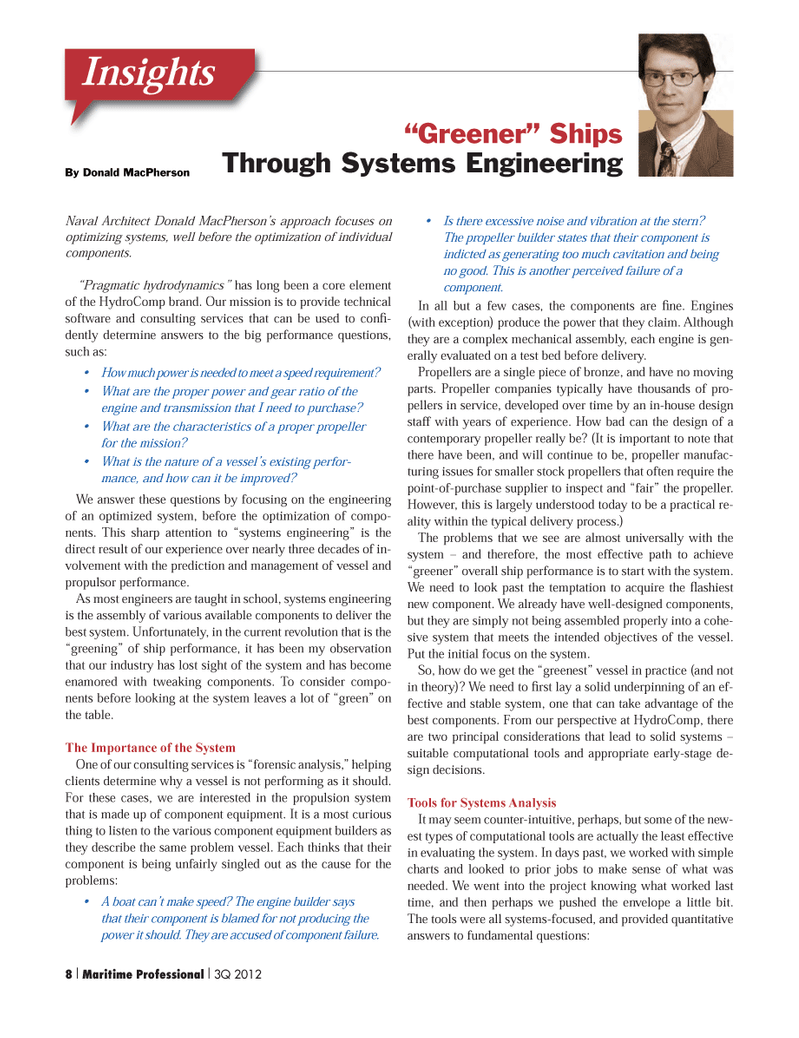
Page 8: of Maritime Logistics Professional Magazine (Q3 2012)
Classification Societies, Quality & Design
Read this page in Pdf, Flash or Html5 edition of Q3 2012 Maritime Logistics Professional Magazine
Naval Architect Donald MacPherson?s approach focuses on optimizing systems, well before the optimization of individual components.?Pragmatic hydrodynamics? has long been a core element of the HydroComp brand. Our mission is to provide technical software and consulting services that can be used to conÞ -dently determine answers to the big performance questions, such as: How much power is needed to meet a speed requirement? What are the proper power and gear ratio of the engine and transmission that I need to purchase? What are the characteristics of a proper propeller for the mission? What is the nature of a vessel?s existing perfor- mance, and how can it be improved? We answer these questions by focusing on the engineering of an optimized system, before the optimization of compo-nents. This sharp attention to Òsystems engineeringÓ is the direct result of our experience over nearly three decades of in- volvement with the prediction and management of vessel and propulsor performance. As most engineers are taught in school, systems engineering is the assembly of various available components to deliver the best system. Unfortunately, in the current revolution that is the ÒgreeningÓ of ship performance, it has been my observation that our industry has lost sight of the system and has become enamored with tweaking components. To consider compo- nents before looking at the system leaves a lot of ÒgreenÓ on the table.The Importance of the SystemOne of our consulting services is Òforensic analysis,Ó helping clients determine why a vessel is not performing as it should. For these cases, we are interested in the propulsion system that is made up of component equipment. It is a most curious thing to listen to the various component equipment builders as they describe the same problem vessel. Each thinks that their component is being unfairly singled out as the cause for the problems: A boat can?t make speed? The engine builder says that their component is blamed for not producing the power it should. They are accused of component failure. Is there excessive noise and vibration at the stern? The propeller builder states that their component is indicted as generating too much cavitation and being no good. This is another perceived failure of a component.In all but a few cases, the components are Þ ne. Engines (with exception) produce the power that they claim. Although they are a complex mechanical assembly, each engine is gen- erally evaluated on a test bed before delivery. Propellers are a single piece of bronze, and have no moving parts. Propeller companies typically have thousands of pro- pellers in service, developed over time by an in-house design staff with years of experience. How bad can the design of a contemporary propeller really be? (It is important to note that there have been, and will continue to be, propeller manufac- turing issues for smaller stock propellers that often require the point-of-purchase supplier to inspect and ÒfairÓ the propeller. However, this is largely understood today to be a practical re- ality within the typical delivery process.) The problems that we see are almost universally with the system Ð and therefore, the most effective path to achieve ÒgreenerÓ overall ship performance is to start with the system. We need to look past the temptation to acquire the ß ashiest new component. We already have well-designed components, but they are simply not being assembled properly into a cohe- sive system that meets the intended objectives of the vessel. Put the initial focus on the system.So, how do we get the ÒgreenestÓ vessel in practice (and not in theory)? We need to Þ rst lay a solid underpinning of an ef- fective and stable system, one that can take advantage of the best components. From our perspective at HydroComp, there are two principal considerations that lead to solid systems Ð suitable computational tools and appropriate early-stage de-sign decisions.Tools for Systems Analysis It may seem counter-intuitive, perhaps, but some of the new- est types of computational tools are actually the least effective in evaluating the system. In days past, we worked with simple charts and looked to prior jobs to make sense of what was needed. We went into the project knowing what worked last time, and then perhaps we pushed the envelope a little bit. The tools were all systems-focused, and provided quantitative answers to fundamental questions:?Greener? Ships Through Systems EngineeringBy Donald MacPhersonInsights8 I Maritime Professional I 3Q 2012MP #3 1-17.indd 8MP #3 1-17.indd 88/14/2012 5:03:22 PM8/14/2012 5:03:22 PM

 7
7

 9
9
